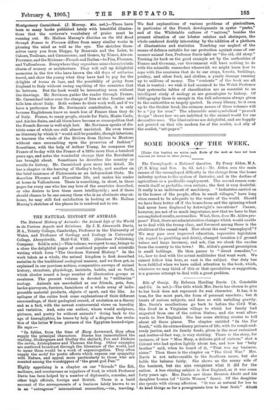The Natural History of Animals : the Animal Life of
the World in its Various Aspects and Relations. By J. R. Ainsworth Davis, MA., Trinity College, Cambridge, Professor in the University of Wales, and Professor of Geology and Zoology in University College, Aberystwith. Half-Vol. VIII. (Gresham Publishing Company. Sold in sets.)—This volume, we regret to say, brings to a close the delightful pages of combined popular and scientific writing which form "The Gresham Natural History." In the work taken as a whole, the animal kingdom is first described seriatim in the traditional zoological manner, and we then get, as explained in our previous notices, comparative surveys of animal history, structure, physiology, instincts, habits, and so forth, which cluster round a large number of illustrative groups or creatures. The present volume is devoted to " utilitarian" zoology. Animals are marshalled as our friends, pets, foes, larder-purveyors, furriers, furnishers of a whole array of indis- pensable material products, objects of sport, and the like. As epilogue of the entire book come explanations of their different surroundings, of their geological record, of evolution as a theory and as a fact, with the newest controversial views on heredity and variation. And, asks our author, where would sculpture, pictures, and poetry be without animals ? Going back to the age of hieroglyphics, he traces by help of a diagram the evolu- tion of the letter V from pictures of the Egyptian horned-viper. He says :—
"In fables, from the time of 2Esop downward, they often supply the principal characters. Sterne has immortalised the starling, Shakespeare and Shelley the skylark, Poe and Dickens the raven, Aristophanes and Thoreau the frog. Other examples are scattered broadcast through the literature of the world, and to name them would be a work of supererogation. They often supply the motif for poetic efforts which express our sympathy with Nature, and appeal more particularly to those who are counted among the worshippers of the great god Fan.'"
Highly appetising is a chapter on our " friends " the fish, molluscs, and crustaceans as suppliers of food, in which Professor Davis has been helped by a number of diplomatic, consular, and other high officials, foreign and British. There is a lucid account of the arrangements of a business lately known to us in an " outrageous " international connection,—viz., trawling.
We find explanations of various problems of pisciculture, in particular of the French developments in oyster "parks," and of the Whitstable culture of " natives," besides the present situation of our lobster catches and shrimpers, the whole rendered doubly interesting by the addition of a plethora of illustrations and statistics. Touching our neglect of the means of defence suitable for our protection against some of our meaner animal foes, Professor Davis tells us "the old, old story." Turning its back on the good example set by the authorities of France and Germany, our Government will have nothing to do with the scientific researches wherewith we might learn how to cope with the creatures that do to our crops, forests, buildings, poultry, and other food, and clothes, a yearly damage running up to millions of money. The "contents" of the book aro all that is wanted : we wish it had occurred to the Welsh Professor that systematic tables of classification are as essential to an intelligent study of zoology as are genealogies to history. Of bibliography there is enough in the full references always given to the authorities so largely quoted. In every library, be it oven up to the Grolier level, the crimson covers of these volumes will be a "joy for over." Tho admirable semi-symbolical "peacock design" shows how we are indebted to the animal world for our decorative uses. The illustrations are delightful, and are happily not printed on that vile modern foe of the reader, a:id ally of the oculist, "art-paper."










































 Previous page
Previous page